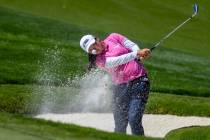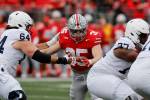Ball not in drop zone still considered in play
Q. I was following my niece during the UNLV women's collegiate tournament at Boulder Creek last month and observed something I have been meaning to clarify with you. Her ball went into the water hazard on the 17th hole and she decided to use the drop zone. When she dropped her ball it landed in the drop zone and then rolled about a foot outside of it. I thought since the ball ended up outside of the drop zone she should have to redrop the ball. The rules official said her ball was in play. Was the official right? -- Sally Turner
A. The official was correct, the ball was in play. Here are some guidelines for drop zones.
n The player does not have to stand within the drop zone when dropping the ball.
n The dropped ball must first strike a part of the course within the drop zone.
n If the drop zone is defined by a line, the line is within the drop zone.
n The dropped ball does not have to come to rest within the drop zone.
n The dropped ball must be redropped if it rolls and comes to rest in a position covered by Rule 20-2c.
n The dropped ball may roll nearer the hole provided it comes to rest within two club-lengths of the spot where it first struck a part of the course within the drop zone.
Q. I played a ball which I thought would be lost in the woods so I correctly played a provisional ball. My provisional ball went into the same area as my original ball. We found both balls but they had identical markings on them. What is the ruling? Are both balls lost and did I have to go back to the tee hitting five? -- Tom Miller
A. This is one of the reasons the rules recommend that you put an identifying mark on your golf ball. One could argue that both balls are lost, however, it would be inequitable to require the player to return to the tee, playing five, when the player has found both balls but does not know which is the original and which the provisional. Accordingly, you must select one of the balls, treat it as the provisional ball and abandon the other. You would be lying three playing your fourth shot.
Q. My ball was on the fringe and my fellow competitor asked me to mark it because it was interfering with his stroke. I always draw a line on my ball, and when I putt I line this up with the hole to indicate the line of play. When it was my turn to play, I replaced my ball on the fringe and lined up this line with the hole. My fellow competitor said I had to replace the ball exactly the way it was before lifting it. He said it was a penalty if I replaced it any other way, I say he is wrong and as long as I replace it in its original spot there is no penalty. -- Jim Dent
A. You are right and there would be no penalty as long as you replace your ball back in its original spot.
Q. My partner marked my ball for me on the putting green and we were told that only my partner could replace the ball back where it was. Is this true? -- Shelly Wright
A. No this is not true. A ball to be placed under the rules must be placed by the player or his partner. If a ball is to be replaced, the player, his partner or the person who lifted or moved it must place it on the spot from which it was lifted or moved. If the ball is placed or replaced by any other person and the error is not corrected as provided in Rule 20-6, the player incurs a penalty of 1 stroke.
Sue May is a U.S. Open rules official, a member of the USGA Senior Women's committee and tournament director of the Women's Trans National Championship. Address your rules questions to suemay@cox.net.























